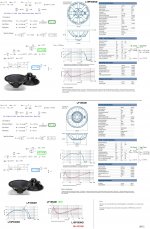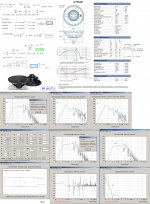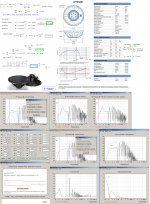Hello.Does anyone have an experience on these drivers?Or some advice?I want to make a subwoofer with this and use it for home cinema and also for hi end system(2fullrange + subwoofer).I will use it for my 20m2 little saloon but in future i may move to a bigger house.In my country we can not find hi end subwoofers and i am tend to use PA woofers.They can be found easily here(also shipping is very expensive for big subwoofers from USA and EU)
The L18P300ND finds its application in bass reflex and band pass system.. Its
capacity to reproduce extremely low frequencies along with extraordinary definition
make it a no compromise woofer in its category, ideal for live and recorded music.
here is link
http://images4.thomann.de/pics/atg/atgdata/document/specs/207010.pdf
Parameters seems good.Better than most hi end subs.And price is also good in Turkey.Eminence drivers are 2 times expensive than USA prices but RCF brand subwoofers and drivers are at same price.So i think i will have a very good subwoofer in a good price.I will not pay for shipping costs.Little hi end subs with shipping cost makes same price so i want to try this subwoofer.
I did not have an experiment with pro drivers but i listened to one subwoofer with pro driver and it was really really wonderful.I did not remember the brand
Can it give good sound with low distortion between 1-10 watts power too?I do not know anything about this.
Waiting some reply.Thanks in advance.
The L18P300ND finds its application in bass reflex and band pass system.. Its
capacity to reproduce extremely low frequencies along with extraordinary definition
make it a no compromise woofer in its category, ideal for live and recorded music.
here is link
http://images4.thomann.de/pics/atg/atgdata/document/specs/207010.pdf
Parameters seems good.Better than most hi end subs.And price is also good in Turkey.Eminence drivers are 2 times expensive than USA prices but RCF brand subwoofers and drivers are at same price.So i think i will have a very good subwoofer in a good price.I will not pay for shipping costs.Little hi end subs with shipping cost makes same price so i want to try this subwoofer.
I did not have an experiment with pro drivers but i listened to one subwoofer with pro driver and it was really really wonderful.I did not remember the brand
Can it give good sound with low distortion between 1-10 watts power too?I do not know anything about this.
Waiting some reply.Thanks in advance.
umut1001,
I don't know that particular speaker itself but I will attest to the quality of the RCF products. These would be of a higher quality than the eminence and as long as they have the fs value that you need to produce the lowest frequency you are after I don't think that you would be making a mistake using this brand of devices. Good luck on your design.
I don't know that particular speaker itself but I will attest to the quality of the RCF products. These would be of a higher quality than the eminence and as long as they have the fs value that you need to produce the lowest frequency you are after I don't think that you would be making a mistake using this brand of devices. Good luck on your design.
Thank you Kindhornman.You are speaking what i want to hear 
This sentence impressed me in datasheet "Its
capacity to reproduce extremely low frequencies along with extraordinary definition"
It means it is hi-end for me.
I am searching if there is a better driver.Drivers must be B&C or RCF.Because of they are made in Italy,they are cheaper and better(because of Italy is not far from Turkey,it reduces shipping costs,so i can buy a better driver in a better price)
Onur İlkorur(acoustic engineer) claimed that Eighteen sound 15NLW900 is very good but in datasheet only advantage over RCF L18p300ND is the "Le" parameter and slightly better Xmas.
Some people claim Pro drivers are good for home,some says bad.I will try them asap.
If you find a better driver please tell me(only Italian drivers because they can be found in Turkey very easily and also in a good price )
This sentence impressed me in datasheet "Its
capacity to reproduce extremely low frequencies along with extraordinary definition"
It means it is hi-end for me.
I am searching if there is a better driver.Drivers must be B&C or RCF.Because of they are made in Italy,they are cheaper and better(because of Italy is not far from Turkey,it reduces shipping costs,so i can buy a better driver in a better price)
Onur İlkorur(acoustic engineer) claimed that Eighteen sound 15NLW900 is very good but in datasheet only advantage over RCF L18p300ND is the "Le" parameter and slightly better Xmas.
Some people claim Pro drivers are good for home,some says bad.I will try them asap.
If you find a better driver please tell me(only Italian drivers because they can be found in Turkey very easily and also in a good price )
Umut,
You really can't go wrong with either of those companies as long as you have the proper fs value and efficiency rating. They are both very well made products from two companies that I can highly recommend from the proaudio side of things. Good luck on your project, I don't think that you will be disappointed if you use either one of the brands. They are both well known to me here in the USA and both are highly regarded here.
You really can't go wrong with either of those companies as long as you have the proper fs value and efficiency rating. They are both very well made products from two companies that I can highly recommend from the proaudio side of things. Good luck on your project, I don't think that you will be disappointed if you use either one of the brands. They are both well known to me here in the USA and both are highly regarded here.
Yes i see.What about this driver?
http://images4.thomann.de/pics/atg/atgdata/document/specs/114043.pdf
It seems it is better for critical studio applications because it has better Xmas.But Le parameter is higher.It is 2,5mH
I read something about Le parameters on diyaudio.Some people says it is important some says not important.Does it affect speed of the driver much?What do you think?
http://images4.thomann.de/pics/atg/atgdata/document/specs/114043.pdf
It seems it is better for critical studio applications because it has better Xmas.But Le parameter is higher.It is 2,5mH
I read something about Le parameters on diyaudio.Some people says it is important some says not important.Does it affect speed of the driver much?What do you think?
That is one hell of a driver there! It is rather large and is going to need a large enclosure to go with it to produce the low frequency you desire. The LE figure is for 1Khz and you really won't be using this driver that high in the band for a sub woofer so I wouldn't worry about that. If you want to use the driver much over 150hz I would add a Zobel network immediately before the binding post on the speaker to tame the impedance rise. The efficiency is certainly high enough to work without needing massive amounts of power. This truly is a proaudio driver made for concert sound levels. It would work nicely in my double 18" bass horn enclosures! The moving mass is going to set the speed of the driver as much as anything else that I see. It does however seem to be massive overkill for such a small room as you are going to use these in.
Omniflex,
Don't confuse power handling with efficiency. The efficiency will tell you where you are with power requirements not the ultimate upper level power handling limits.
And don't confuse a small driver to an 18-inch driver. You need current to drive an 18-inch woofer.
Considering 10 watts @ 8-ohms offers a current of 1.1 amps or 8.9 volts, I'm not sure what is the benefit of attaching a 10-watt amplifier to an 18-inch Pro Audio woofer.
From an asthetic point of view it may look impressive but, the amplifier will run into clipping before the loudspeaker's xmax comes into play.
Omni,
I am not saying that he needs an 18" speaker for such a small room. Actually I think the size of the cabinet is going to be more than a bit large for such a small room and I wouldn't want that myself. But as far as the power goes he may only need 1 watt in his room for bass with that efficiency of 99db for one watt. It isn't current he needs it is voltage driving the speaker. I have 6" speakers that could drive you out of the room and the bass is getting down to 35hz so I don't even need to think about large speakers. I can easily hit over 110 db no problem and if I had an 18" speaker putting out massive low bass my neighbors would not be very happy about that. I also build horn loaded systems so I understand both sides of the equation. I see all kinds of overkill here in what people think that they need. But that is their choice to make. I just looked at a thread where the guy was talking about 6 18" speakers in one room for distributed bass. Talking about overkill that is way beyond that.
I am not saying that he needs an 18" speaker for such a small room. Actually I think the size of the cabinet is going to be more than a bit large for such a small room and I wouldn't want that myself. But as far as the power goes he may only need 1 watt in his room for bass with that efficiency of 99db for one watt. It isn't current he needs it is voltage driving the speaker. I have 6" speakers that could drive you out of the room and the bass is getting down to 35hz so I don't even need to think about large speakers. I can easily hit over 110 db no problem and if I had an 18" speaker putting out massive low bass my neighbors would not be very happy about that. I also build horn loaded systems so I understand both sides of the equation. I see all kinds of overkill here in what people think that they need. But that is their choice to make. I just looked at a thread where the guy was talking about 6 18" speakers in one room for distributed bass. Talking about overkill that is way beyond that.
The problem he is going to face is power. As the frequencies go lower, the loudspeaker is going to require more current from the amplifier to give him the SPL (volume) he is seeking. Surely, if he can afford an RCF 18 P 300, he can afford a 200-watt amplifier, which will offer him less distortion in addition to more current on demand when the loudspeaker needs it in order to play lower frequencies.
Hello.Does anyone have an experience on these drivers?Or some advice?I want to make a subwoofer with this and use it for home cinema and also for hi end system(2fullrange + subwoofer).I will use it for my 20m2 little saloon but in future i may move to a bigger house.In my country we can not find hi end subwoofers and i am tend to use PA woofers...
Hi umut,
Good idea, I have built/designed many 'subs' for flea-power amps....
Can it give good sound with low distortion between 1-10 watts power too?I do not know anything about this.
Waiting some reply.Thanks in advance.
Have a look at my suggestions. Both can be driven with a low power amp because the high inherited passband impedance is guaranteed when properly stuffing are applied in these quarter-wave designs.
The current consumption of both are lower than if substituted using an ordinary closed or ported design.
b
Attachments
Last edited:
Hi Bjorno,Both can be driven with a low power amp because the high inherited passband impedance is guaranteed when properly stuffing are applied in these quarter-wave designs.
The Thiele-Small parameters of RCF drivers are measured after a 2 hour warm-up period of full power handling capacity!
Hi.So what will be the technical differences between hot and cold driver?
Hi umut1001,
Djim is right, new High power PA drivers equipped with hard cone suspensions or drivers that have been stored over a longer period after manufacturing are prone to be stiff and have to be 'braked-in' to loosen up the suspensions in order to recover their advertised parameters.
If you have access to an 18-24V Rms >= 50VA(~2Amin) transformer connected directly to the speaker terminals to break in the driver suspension a couple of hours over a period of a few days...
Or by using a power amp and a tone generator set at a few Hz lower than fs where the cone excursion is suspension limited: The driver would show up consistent T/S that will remain very stable particularly if used on a daily basis in a speaker system.
b
PS: http://www.klippel.de/fileadmin/kli...r_Thermal_Parameters_(Convection Cooling).pdf
Hi umut1001,Hi.So what will be the technical differences between hot and cold driver?
Yes, there is a significant difference between a 'hot' and a 'cold' driver. You need proper measurements of a 'cold' driver. Like Bjorno already mentioned, it needs first a break-in-period of the mechanical parts.
umut1001,
Please don't confuse breaking in a driver with the change in impedance values you will see when a driver changes values due to heating of the voicecoil. When you take a driver and exercise it at high excursion with music or with a sine wave this is changing the physical properties of the spider and depending on the type of surround in a permanent way. Once these parts of the suspension are broken in no amount of sitting around is going to change them back to like new unused condition. Measuring the T/S values on a cold loudspeaker verses a heated driver will in fact give you different results. Keep this in mind when working with the values here. If you are only going to use low power amplifiers on a speaker such as the RCF the values you should aim for would not be the same as a PA company is going to need to work with that is driving the same speaker with a 1000 watt amplifier running at this elevated power level over many hours time.
Please don't confuse breaking in a driver with the change in impedance values you will see when a driver changes values due to heating of the voicecoil. When you take a driver and exercise it at high excursion with music or with a sine wave this is changing the physical properties of the spider and depending on the type of surround in a permanent way. Once these parts of the suspension are broken in no amount of sitting around is going to change them back to like new unused condition. Measuring the T/S values on a cold loudspeaker verses a heated driver will in fact give you different results. Keep this in mind when working with the values here. If you are only going to use low power amplifiers on a speaker such as the RCF the values you should aim for would not be the same as a PA company is going to need to work with that is driving the same speaker with a 1000 watt amplifier running at this elevated power level over many hours time.
I want to use one of these PA subs because they have a very good Price quality ratio.They can be found easily here in my country.And also in future when i move to a bigger house i can also use them in every big place for music and cinema.Yes i will break it in.I hope it won't disturb my new neighbours while playing music/cinema Thanks everyone for suggestions.
Thanks everyone for suggestions.
for home cinema ,you would be looking for a driver with a lower fs then that.imo.
also a common mistake is to look at the efficientie figur.
this tels you nothing how it wil preform in the sub range.
also a common mistake is to look at the efficientie figur.
this tels you nothing how it wil preform in the sub range.
rcf:3 Sensitivity measurement is based on a 100-500 Hz pink noise signal with input power of 2.83V @ 8 Ohms
18sound:sensivity represents the averaged value of acoustic output as measured on a forward central axis of a cone,at a distance 1m from the baffle panel,when connected to 2,83v sine wave test signal swept between 100hz and 500 hz with a test specimen mounted in the same enclosure as given for(1) above
- Status
- This old topic is closed. If you want to reopen this topic, contact a moderator using the "Report Post" button.
- Home
- Loudspeakers
- Subwoofers
- RCF L18P300-ND for home


